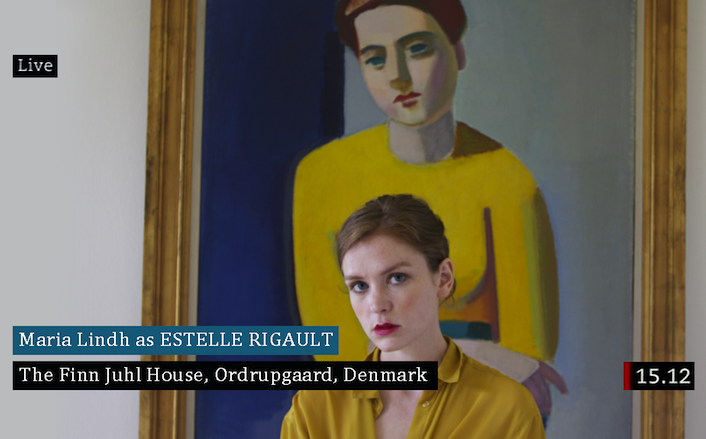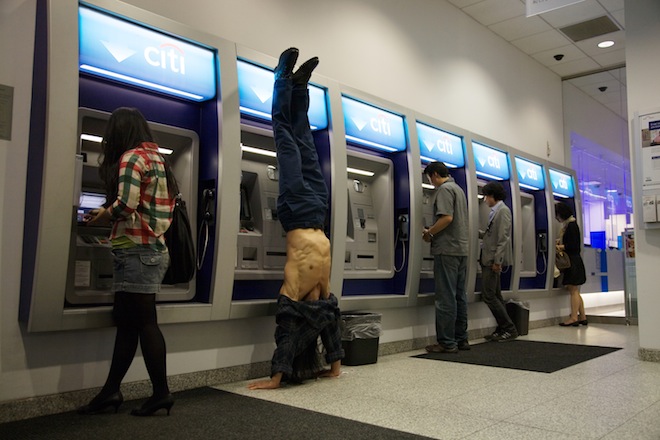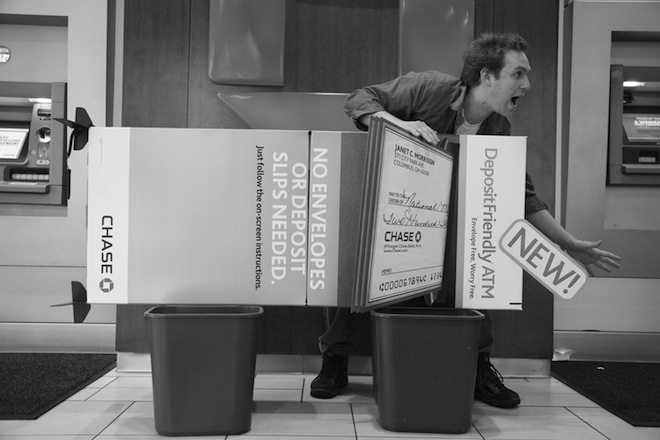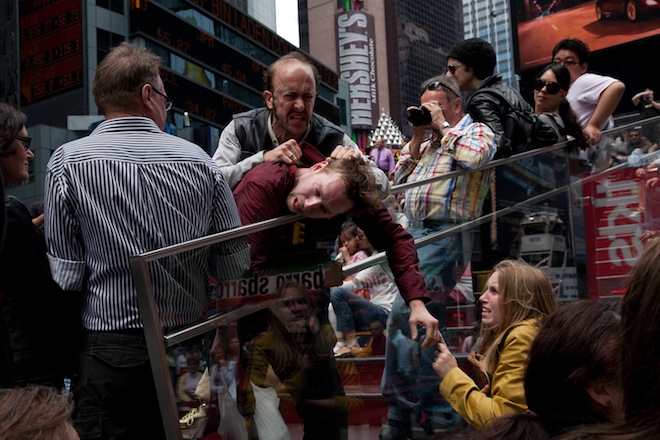ARCHIVE
LIZ MAGIC LASER
interview by Hans Ulrich Obrist

Courtesy of the artist, Malmö Konsthall in collaboration with SVT
LIZ MAGIC LASER For my Performa project I was working with a number of interviews that I was splicing up and adapting into a romantic drama. The first interview I found was the sarah Palin/glenn Beck interview that he starts by saying: “I want to read to you what I wrote about you in my journal last night.”
HANS ULRICH OBRIST Who is speaking?
LML Oh, it’s glenn Beck interviewing sarah Palin. It was supposedly the first time they ever met, and he immediately opened up his diary. The romantic intonations of a teenage 1980s-era film type come up immediately. and then I started to look at other interviews and see that often the dialogue…
HUO Interviews with whom?
LML With american politicians: Obama, Hilary clinton, reagan, Bush one and two. I started to look at how these two roles—politician and journalist—were being cast right now. I saw these moments that interested me, the bits that had an emotional tenor to them, a sense that the politician was trying to prove his or her empathy and humanity and also trying to evoke empathy from the public.
HUO So the question is about the interview being a vehicle for empathy?
LML Yes.
HUO Jeremy Rifkin [the American economist] wrote that in the 21st century only empathy can save us from all the big crises in the world.
LML I haven’t read him, I should take a look. I was coming to it from an early avant-garde reaction.

Courtesy of the artist
HUO In the early 20th century?
LML Exactly. There was a reaction against the use of empathy in theater, which had been used to keep the audience hypnotized and passive. I think that this reaction gets misinterpreted as anti-emotional. I was looking at meyerhold and Brecht, and I was reading more critical essays that discussed the entire historical moment. There were things like [Meyerhold’s production of Marcel Martinet’s] “The earth in Turmoil,” and a few others where they were using a montage technique to reconstitute melodramas that were all about evoking empathy in the audience.
HUO When you do this performance for your exhibition, will it be live in front of the public or not? Do you have a public? if you call it a performance I suppose there is a public?
LML in the case of the performance that I did in the movie theater [I Feel Your Pain, 2011], the audience is actually in the film. so they are watching the film, and it’s also happening right next to them. so most people were still quite overwhelmed with the image on the big screen and only occasionally looked back at what was unfolding beside them. In this new piece, The Digital Face, I will do the same; the audience will also play a part. For both of these pieces, with the staircase one as well [Flight, 2009–10], the performance doesn’t exist until the audience is there. and this is really difficult for the performers I am working with: the scenario can’t be fully rehearsed until the audience is present. I suppose I am always interested in the audience being implicated completely.
HUO You said before that the camera that films the performance has a constitutive presence. so one could say that the audience has also a constitutive presence: there is absolutely no outside—everything is the performance.
LML That’s correct. I would say that the cameras and the audience are complicit, are forced into being complicit. This is especially the case with Flight and I Feel Your Pain. The latter title is a quote from something clinton said to Bob rafsky, an activist who heckled him at a campaign rally during his first run for the presidency. clinton really shut rafsky down, condescending to him as one would to a woman. This is where I was going with that prior line of thinking. as I started to watch these interviews, I saw that the relationship between the journalist and the politician was either one where the journalist was admiring the public figure and acting in an almost flirtatious manner or was antagonistic and scornful. Both cases fall into tropes from popular film of the romantic relationship. so in this type of political interview, the journalist is basically the voice of the people, asking “what the people want to know,” and is simultaneously taking on these female stereotypes in a way that has the character of a gendered power dynamic. But I was going to tell you about the new performances. I picked up these François Delsarte books a few years back, as I was looking into melodrama in film.

Courtesy of the artist
HUO Which books are they?
LML The Art of Oratory, System of Delsarte [1884]. I think it was his student and his widow who put together this collection of his lessons and his theories on oratorical gestures. He was developing this material in the 1830s to codify gestures of persuasion. He broke them down to examine how each gesture can emotionally manipulate the audience. He developed this technique of envisioning an invisible cube and gave distinct meanings to “touching” each side of the cube. If you touch the bottom side you are telling people you are going to take care of them. If you touch the top, then you are telling them that you have control over the situation. These theories influence Stanislavski’s method acting, but it was also written for the public figure. I was curious, because, from moment one, the methods of theater and politics are intertwined, but in the case of politics a convincing performance is directly garnering power. I was interested in the earlytwentieth-century moment when the soviet and german avant-garde reacted against these methods, but the truth is that these techniques are being used to a more extreme degree now. I’ve spoken to public-speaking coaches and almost all have a background in theater. The expert advisors that a politician must have now function like dramaturges and stage managers do in the theater. Political consultants look at the types of things that worked for others in the past and what moves can be redeployed now. so, for instance, reagan talks about gorbachev in incredibly romantic terms: he describes his seduction of him, with a fireplace in the background in geneva. When they’re at the conference, reagan says to him: “Do you want to step outside for a breath of fresh air?” He reminisces about taking gorbachev for a walk down to the water and the fireplace was going and “we talked for hours, and I looked into his eyes.” Then, years later W [Bush] speaks in the same manner about Putin.
HUO Nothing of this early critique of empathy, particularly related to the russian avant-garde you mentioned, seems to have entered into daily use now; it’s not really used.
LML It is. There’s [the late American neoconservative] andrew Breitbart; there’s the Yes men, it’s a type of agitprop; and there’s reality television. This is interesting to me as well, that somebody like Breitbart is more effective than the Yes men.
HUO Can you tell me about andrew?
LML He used social interventions. For example, he’d have someone dress up as a prostitute and go to american public services for help, and then have their john come in, and they’ll still get help. and he’d videotape this. He was an extreme right-winger who used agitprop techniques. I’m concerned with how these emotionally compelling languages are being fought over, the rapid cycle of appropriation and recuperation. I saw the most recent state of the Union address by Obama, and he was quite active with his hands the entire time—he might as well have been signing—and I wanted to look back at how this demonstrative method has come to be used this way. and I imagined that reagan would be the first because he was called “The great communicator.”

Courtesy of the artist
HUO So he was the first to use his hands?
LML He wasn’t. This is what I had imagined. But then I started to look and he did not move his hands at all. He had them fixed on his script and most of his speeches are filmed from closeup. This was also the case with carter and Ford and everyone before reagan, so my theory is that when these types of speeches started being televised, I believe that the experts told the figures to cut out the gestures.
HUO To stop the hand thing?
LML Yeah. It doesn’t jive well with the mediations.
HUO It doesn’t look good on television?
LML Or so they thought… this is my theory. Over reagan’s tenure, the camera starts to zoom out more, to go wide, and then it turns out Bush senior is the first to bring back the oratorical gestures. so I was interested in this shift in approach and how politicians are trained for these precise movements.
HUO An endless flow of arms. This is fascinating: you basically looked at the whole history and how it changed from empathy to non-empathy and then to the return of empathy. But it’s also interesting that with reagan the world of cinema entered politics as a kind of reality. I don’t know if
you’re familiar with the designer Ken adam—he did the film sets for James Bond movies—but I interviewed him a couple of times. He designed stanley Kubrick’s movies: Barry Lyndon, the war room in Dr. Strangelove. and the war room is almost like architecture, confirming his idea that cinema stage sets can actually become like real architecture, because people know it now like they know real buildings. so when reagan was elected to office, the rumor goes that he was late to start the first couple of days at the White House because he couldn’t find the war room. He really thought that the war room would be a reality.
LML Beyond that, this fiction of a war room has itself become the model for “the situation room,” which is one of the organizing myths of our 24-hour news cycle. so this fantasy of a global panopticon has become the public stage through which reality is dramatized.



